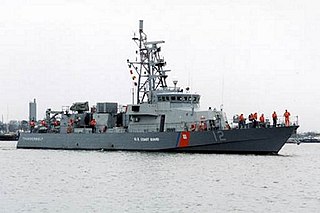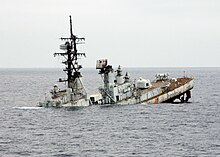
A torpedo boat is a relatively small and fast naval ship designed to carry torpedoes into battle. The first designs were steam-powered craft dedicated to ramming enemy ships with explosive spar torpedoes. Later evolutions launched variants of self-propelled Whitehead torpedoes.

A naval ship is a military ship used by a navy. Naval ships are differentiated from civilian ships by construction and purpose. Generally, naval ships are damage resilient and armed with weapon systems, though armament on troop transports is light or non-existent.

The Flyvefisken-class patrol vessels are warships of the Royal Danish Navy. The class is also known as the Standard Flex 300 or SF300 class. The five vessels sold to the Portuguese Navy are locally referred as Tejo class.

A target tug is an aircraft which tows an unmanned drone, a fabric drogue or other kind of target, for the purposes of gun or missile target practice. Target tugs are often conversions of transport and utility aircraft, as well as obsolescent combat types. Some, such as the Miles Martinet, were specially designed for the role. It was, and is, a relatively hazardous job, as live fire is typically employed and the people doing the shooting are usually still in training.

A target ship is a vessel — typically an obsolete or captured warship — used as a seaborne target for naval gunnery practice or for weapons testing. Targets may be used with the intention of testing effectiveness of specific types of ammunition; or the target ship may be used for an extended period of routine target practice with specialized non-explosive ammunition. The potential consequences of a drifting wreck require careful preparation of the target ship to prevent pollution, or a floating or submerged collision risk for maritime navigation.

Sea Fighter (FSF-1) is an experimental littoral combat ship in service with the United States Navy. Its hull is of a small-waterplane-area twin-hull (SWATH) design, provides exceptional stability, even on rough seas. The ship can operate in both blue and littoral waters. For power, it can use either its dual gas-turbine engines for speed or its dual diesel engines for efficient cruising. It can be easily reconfigured through the use of interchangeable mission modules. Helicopters can land and launch on its deck. Smaller water craft can be carried and launched from its stern. The vessel is being developed under the program title Littoral Surface Craft-Experimental with a hull type designation Fast Sea Frame. The first vessel has been assigned the hull classification symbol FSF 1 and also has been referred to as the X-Craft. The vessel was designed by British company BMT Nigel Gee Ltd who continue with a role in the development of the vessel.

The Type 143 Albatros class was a class of missile bearing fast attack craft. Each vessel is named after a bird of prey including the albatross, condor and cormorant. Constructed by German shipbuilders Lürssen and Kröger, the vessels were intended to replace the Type 141 Seeadler class. The German Navy retired the class in 2005 and sold the boats off to Tunisia and Ghana.

USS Thunderbolt (PC-12) is the twelfth Cyclone-class patrol ship. Thunderbolt was laid down 9 June 1994 by Bollinger Shipyards, Lockport, Louisiana, and launched 2 December 1994. She was commissioned by the United States Navy on 7 October 1995.

An unmanned surface vehicle, unmanned surface vessel or uncrewed surface vessel (USV), colloqually called a drone boat, drone ship or sea drone, is a boat or ship that operates on the surface of the water without a crew. USVs operate with various levels of autonomy, from remote control to fully autonomous surface vehicles (ASV).

The TF-2000-class destroyer is a projected anti-air warfare guided-missile destroyer currently undergoing development by the Turkish Naval Institute. The class will provide survivability in the presence of aerial threat and also support mission functions such as command, control, and communications, reconnaissance, early warning, surface warfare, anti-submarine warfare and electronic warfare. Moreover, once in service, the TF-2000s are slated to be an integral part of Türkiye's expeditionary strike groups centered around the TCG Anadolu LHD and the country's future aircraft carrier(s). The TCG Anadolu is to be followed up by the TCG Trakya light aircraft carrier and President Erdoğan has also hinted at the construction of a larger aircraft carrier that is to be designed in cooperation with Spain. These capital vessels require destroyer escorts to defend them against enemy aircraft, ships and submarines; in other words, the perfect role for the TF-2000s once these new designs are slated for operational service by 2038. On 5 December 2007, Defence Industry Executive Committee approved plans to build six ships of this class. In January 2013, it was announced that Turkey was planning to acquire a total of 8 TF-2000 destroyers, which was confirmed at the International Defence Industry Fair (IDEF) 2021. With the realization of the project, it is intended to improve the anti-air warfare (AAW) capabilities of the Turkish Navy.

The ASW Continuous Trail Unmanned Vessel (ACTUV) is a DARPA funded project launched in early 2010 to develop an anti-submarine drone. ASW is an acronym for Anti-Submarine Warfare. In January 2018 after successful sea trials it was announced that the "Sea Hunter" prototype has transitioned from DARPA to the Office of Naval Research for further development.

USNS Spearhead (JHSV-1/T-EPF-1) is the lead ship of the Spearhead-class expeditionary fast transport to be operated by the United States Navy's Military Sealift Command. USNS Spearhead was christened on 17 September 2011.

The Fleet-class unmanned surface vessel, also called the Common Unmanned Surface Vessel (CUSV) and later the Mine Countermeasures Unmanned Surface Vehicle, is an unmanned surface vessel designed for the United States Navy to be deployed from Freedom and Independence-class littoral combat ships and intended to conduct mine and anti-submarine warfare missions. As of 2012 four units of the class have been built; the first was delivered to the U.S. Navy in 2008.
The Hammerhead USV-T is a remote-controlled, high-speed seaborne target drone used for naval training. The craft is built and produced by Meggitt Training Systems in cooperation with A. F. Theriault & Son Ltd and approximately 80 other companies that produce innards and accessories of the boats. The Hammerhead USV-T is used for tactical training scenarios at sea.

The Marine Branch (1918–1986) was a branch of the Royal Air Force (RAF) which operated watercraft in support of RAF operations. Just days after the creation of the RAF itself, the Marine Craft Section (MCS) was created with the transfer of Royal Naval Air Service (RNAS) vessels and personnel to the new service. Originally tasked with the support of RNAS, and later RAF, seaplanes, Marine Craft Section was to achieve its greatest size during the Second World War, and achieved fame for its role in air-sea rescue operations. After the war MCS was granted full branch status on 11 December 1947; however, post-war the role of the new branch became greatly reduced with the end of the British Empire, the withdrawal of flying boats from service, and the increasing use of helicopters in air-sea rescue. The branch was disestablished on 8 January 1986.

Sea Hunter is an autonomous unmanned surface vehicle (USV) launched in 2016 as part of the DARPA Anti-Submarine Warfare Continuous Trail Unmanned Vessel (ACTUV) program. The ship was christened 7 April 2016 in Portland, Oregon. It was built by Vigor Industrial. The vessel continues the line of experimental "Sea" ships, including Sea Shadow, Sea Fighter, Sea Jet, and Sea Slice. Sea Hunter is classified as a Class III USV and designated the Medium Displacement Unmanned Surface Vehicle (MDUSV).
BRP Federico Martir (PC-385) is fourteenth ship of the Jose Andrada-class patrol craft coastal patrol craft of the Philippine Navy. It is part of the second batch of its class ordered through US Foreign Military Sales (FMS) in 1993, and was commissioned with the Philippine Navy on 22 May 1996. She is currently in active service with the Littoral Combat Force, Philippine Fleet.
The JARI USV is an uncrewed surface vehicle developed by the China Shipbuilding Industry Corporation (CSIC), specifically between its No. 716 Research Institute, the Jiangsu Automation Research Institute (JARI), and No. 702 Research Institute, China Ship Scientific Research Centre (CSRRC). The uncrewed warship is designed for potential use for the People's Liberation Army Navy and export customers.

United States Navy submarines, surface ships, and aircraft launch torpedoes, missiles, and autonomous undersea vehicles as part of training exercises. Typically, these training munitions have no warhead and are recovered from the sea and reused. Similarly, new naval weapons under development are launched at sea in performance trials. These experimental units also need to be recovered, in their case to obtain evaluation data. At various points in history, newly manufactured torpedoes were fired as a quality control measure and these, too, had to be recovered before issuing them to the fleet. The U.S. Navy has used a variety of boats to accomplish the retrieval of these test and training munitions. As their missions evolved over the last century they have been variously known as torpedo retrievers, torpedo weapon retrievers, torpedo recovery boats, range support craft, and multi-purpose craft.

The Baykar Bayraktar TB3 is a Turkish medium-altitude long-endurance (MALE) unmanned combat aerial vehicle (UCAV) capable of short-range landing and take-off, produced by Baykar. It is currently being developed due to the lack of aircraft to be deployed on the TCG Anadolu amphibious assault ship. According to the initial plans the ship was expected to be equipped with Lockheed Martin F-35B Lightning II fighter jets but following the removal of Turkey from the procurement program, the vessel entered a modification process to allow it to be able to accommodate UAVs.




















